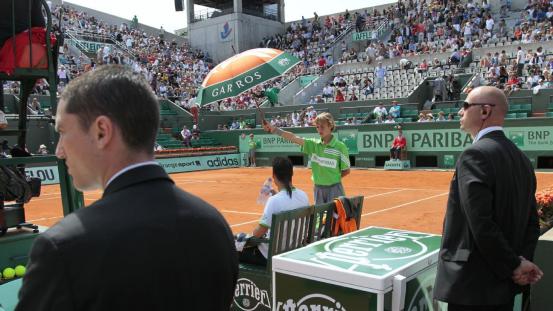- Commissioner’s statement on Ventura, Marte
- Ronnie O’Sullivan: Masters champion ‘felt so vulnerable’ in final
- Arron Fletcher Wins 2017 WSOP International Circuit Marrakech Main Event ($140,224)
- Smith challenges Warner to go big in India
- Moncada No. 1 on MLB Pipeline’s Top 10 2B Prospects list
- Braves land 2 on MLB Pipeline’s Top 10 2B Prospects list
- Kingery makes MLB Pipeline’s Top 10 2B Prospects list
- New Zealand wrap up 2-0 after Bangladesh implosion
- Mathews, Pradeep, Gunathilaka to return to Sri Lanka
- Elliott hopes for rain for Poli
No easy answer when it comes to increased security measures
- Updated: May 21, 2016

11:47 AM ET
PARIS — In years past, the French Open has been the sleepy Slam.
Roland Garros, where the tournament is played, is a 21-acre venue in the southwest corner of the city that since 1928 has featured the best set of red-clay tennis courts in the world, pristine gardens and the quaint, casual air of another era.
Laissez-faire, a French term for “hands off,” is the perfect description for what Roland Garros was — until a year ago.
When a selfie-seeking fan jumped out of the stands on the first day and accosted Roger Federer on Court Philippe Chatrier, it left lingering questions about the French Tennis Federation’s security protocols. Similar incidents involving trespassing fans happened during a match involving Federer in 2013 and again during a doubles match in 2009.
Then last November, the terrorist attacks at Stade de France in suburban Saint-Denis and at restaurants and a music venue in central Paris resulted in 137 deaths. Concerns were ratcheted up again by the attacks in nearby Belgium and the Egyptian Airlines flight that left Charles de Gaulle airport outside Paris bound for Cairo Thursday and disappeared over the Mediterranean.
The French Open has added 25 percent more security personnel than it had one year ago. JACQUES DEMARTHON/Getty Images
The 2016 French Open is the first major international sporting event to be held in Paris since those events. Saturday, the day before the main draw was scheduled to begin play, Roland Garros looked like a fortress outside. Entering the grounds has become far more time-consuming and complicated.
There were groups of gendarmes wearing machine guns outside the venue, longer lines for spectators and media members who are required to open their bags, pass through metal detectors and, for the first time, undergo pat-downs by security guards before entering. Once inside, police with explosive-sniffing dogs now patrol the grounds, and discreetly placed security cameras keep an eye on everything.
A year ago, the Federation made a point of saying it would not increase security in the wake of the Federer episode but, rather, deploy it in a more obvious manner. That philosophy has changed this year, too, says French …
continue reading in source espn.go.com
